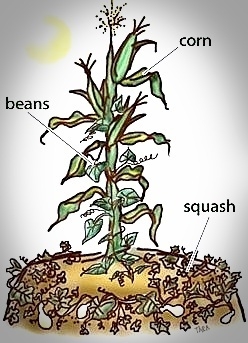Advice for the Home Gardener from the Help Desk of the
UC Master Gardener Program of Contra Costa County
Client: I've heard various local home gardeners talking about planting the “3 sisters” in their vegetable garden. I think they are discussing corn, beans, and squash. Why would I want to plant the 3 sisters?
MGCC Help Desk: Thank you for contacting the UC Master Gardener Program Help Desk regarding growing the “3 sisters.”

from IALF
There are many variations on the 3 sisters garden, but the most traditional layout is something like this: several corn kernels planted in a circle, beans planted close to the corn, and then the squash planted in a wider circle around the inner plantings.
This layout works great for growing dry corn and dry beans. If, however, you'd like to grow sweet corn and snap beans, you should consider an alternative. When growing dry corn and beans, everything is ready for harvest at the same time. But, fresh corn and beans will be ready before squash. You're probably not going to want to carefully step around your pumpkins or watermelon every time you harvest beans or corn, and the squash leaves probably won't appreciate being stepped on either.
In the above situation, an alternate layout is best. Rows of corn with beans planted in between is a great variation, with the option to plant some squash along one side. This variation has the added benefit of increased pollination for the corn. If you have a good amount of space, beans, corn, and squash can be planted in linear plots and used for crop rotation. From left to right, plant squash, then corn, then beans. Each subsequent season, move each crop to the right, so the corn and squash can benefit from the nitrogen-fixed soil the beans grew in.
Companion planting can become a complex set of decisions. You will want to consider the variety of plants you wish to grow and then consider which do well together and which can exacerbate problems by, for example, attracting the same pests. Information regarding companion planting can be found at:
http://marinmg.ucanr.edu/Marin_Master_Gardener_Independent_Journal_Articles/?uid=430&ds=275.
We wish you continued success with your gardening, especially growing the 3 sisters. Please do not hesitate to contact Master Gardeners again if you have further questions.
Help Desk of the Master Gardener Program of Contra Costa County (KR)
Note: The UC Master Gardeners Program of Contra Costa's Help Desk is available year-round (except the last two weeks of December) to answer your gardening questions. Except for a few holidays, we're open every week, Monday through Thursday for walk-ins from 9:00 am to Noon at 75 Santa Barbara Road, 2d Floor, Pleasant Hill, CA 94523. We can also be reached via telephone: (925)646-6586, email: ccmg@ucanr.edu, or on the web at http://ccmg.ucanr.edu/Ask_Us/ MGCC Blogs can be found at http://ccmg.ucanr.edu/HortCoCo/ You can also subscribe to the Blog (//ucanr.edu/blogs/CCMGBlog/)